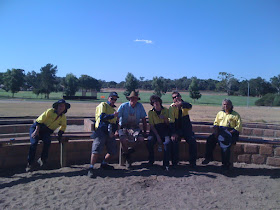I recently spent two days working with bods from a NOW Green program, building seating at the Crossroads Community Garden being developed in Gwelup, Western Australia.
This community garden is a joint project of the Scarborough Church of Christ, City of Stirling, the Department of Health's North Metropolitan Area Health Service, and NOW Green. The Crossroads Community Garden had received grant funding to enable significant expansion.
The project will see an additional 50 garden beds, community meeting area, pizza oven, fruit trees, artwork and more. This would also include some seating in the centre of the circular garden layout. That's where I come in.
|
| The new garden bed walls are in, ready for the seating. |
My role was to work with the mob from NOW Green to lead the building of the central seating using predominantly recycled timber. Due to concerns about termites, CCA treated pine was used for the 16 posts. All the seats and supports were made from salvaged hardwood timber, mostly jarrah, from demolished buildings.
NOW Green is operated under the National Green Jobs Corps program, a Federal Government initiative, by Peedac Pty Ltd. This link will give you some more info about the program:
http://www.peedac.com.au/now-green/ The project helps provide job seekers with a range of new skills, gaining confidence and self esteem and the benefits of social inclusion. The ultimate aim is for the participants to gain employment and increase their involvement in society.
 |
| Docking the seat timbers to length. |
The method of construction involved pairs of seat supports which are housed into checks at the top of each post. These jarrah supports (ex 4" x 2") were bolted to the top of each post with 2 galvanised M10 bolts. The participants cut the housings on the top of each post by hand. Like most woodwork tasks, this involved accurate marking out and good sawing technique. They did a pretty good job at it too. Fixed to the seat supports were pairs of seat timbers (ex 5" x2"), as in the picture. A string line was used from the central point to do the setting out and to ensure that the joints all radiated towards the centre.
 |
| Block planes were used to chamfer the edges of the timber components. |
 |
| Those portable benches are so handy! |
The seat timbers had been machined by me prior to the program, to clean them up, flatten them and give them all a consistent thickness. They were machined to 43mm thick, and the edges left as they were, nail holes and all. Machining these salvaged timbers is a dirty and time-consuming task. Each stick is scrubbed down with a wire brush, scanned with a metal detector, and any found nails and screws removed. One face is flattened over the buzzer and then put through the thicknesser to the required dimension (43mm thick). The process reveals wonderful grain figure and colour in the timber. Delicious!
 |
| A moment of contemplation. Nice job, guys! |
 |
| The second curve of seating making good progress. |
The finish height of the seating will be between 18" and 20" (450 - 500mm). We had to plan for this in the construction, as another layer of sand will be put down before the brick paving is laid. We used a laser level to ensure the tops of the posts were level. This gave us nice level seating.
 |
| A hive of activity. |
 |
| Fixing down the seats with the impact driver. |
 |
| That's me with some of the gang from NOW Green. Job done. |
The particpants can rightfully be proud of the job they have done. It looks very good and provided an opportunity to gain a few skills and learn a few tricks. There are a total of 28 "seat panels" - 14 on each arc. These will all be finished with an oil-based product to help preserve them, after the next part of the seating project is complete.
As a community activity on Harmony Day, people from the local community had the opportunity to carve their family name in a seat panel. My task was to facilitate that process as well.
 |
| A view of the completed seating in the central area. |
 |
| One half of the completed seating. |
Members of the public had the opportunity on Harmony Day to select one of the 28 seat panels to carve their family name on. Two methods were available: Dremel type electric engraving tools, or carving chisels. Participants could choose. People selected their seat panel, unscrewed it and cramped it to a bench. I gave basic instructions, they got to practice on a piece of scrap, draw their designs on their piece of timber, and they commenced carving.
 |
| Using a Dremel to engrave their panel. |
 |
| Using carving chisels. A job for the whole family! |
It was a great day. A wide variety of styles and fonts emerged, with people of all ages having a go.
 |
| Father and son, working together. |

 |
| Nice work! |
 |
| Screwing back down a completed seat panel. |
 |
| A few of the completed panels, now waiting for an oil finish. |
There are still a few blank seat panels, so I wouldn't be surprised if another opportunity is created for the public to add their names to the seating in the middle of the community garden.
It will be great to watch progress on the garden's development. I count it a priveledge to have played a small part by facilitating the building and embellishing of the seating. A job well done by all involved!





















